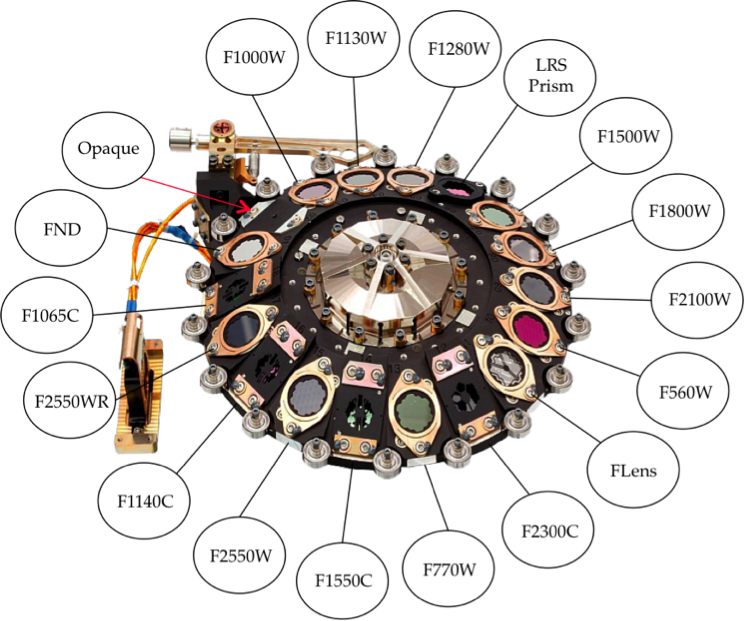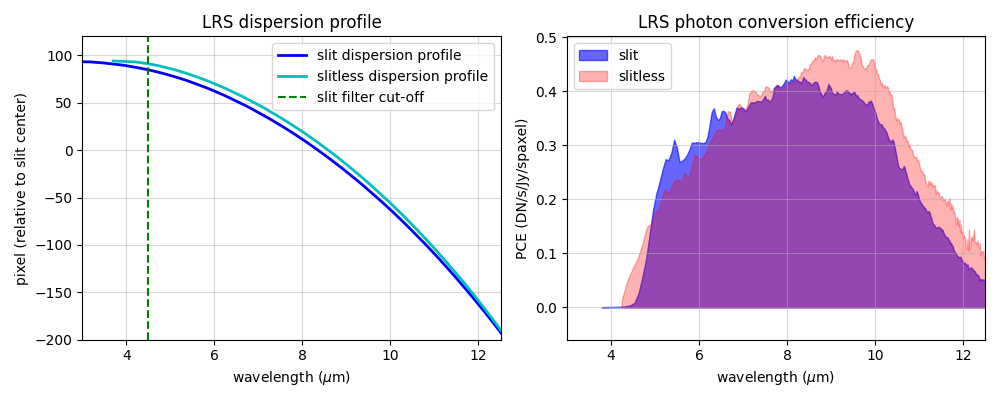MIRI Filters and Dispersers
The MIRI filter wheel has 10 filters for imaging, 4 filter-diaphragm sets for coronagraphy, and one double prism assembly for low-resolution spectroscopy. The medium-resolution spectrometer has 2 wheels for controlling gratings and dichroics positions.
On this page
For the Mid-Infrared Instrument (MIRI), both the imager (MIRIM) and medium-resolution spectrometer (MRS) channels are fed from a single pick-off mirror (POM).
The imager has a single filter wheel that holds all the elements necessary for MIRI's 3 functional areas: imager, coronagraph, and low-resolution spectrometer (LRS). For low-resolution spectroscopy, a double prism is used to disperse the light; it is mounted in the imager filter wheel, with its position designated P750L.
The MRS has its own dichroic filter/grating wheels that move gratings and dichroics simultaneously to allow for a specific wavelength coverage.
Filter throughput curves
When calculating sensitivities, we encourage you to use both the JWST Exposure Time Calculator (ETC) and the ETC engine, named Pandeia. The sensitivities depend on a variety of telescope contributions. Details can be found on the JWST ETC Instrument Throughputs page.
Imager
See also: MIRI Imaging, MIRI Coronagraphic Imaging, MIRI Low Resolution Spectroscopy
The MIRI imager filter wheel includes:
- 10 filters for imaging (F2550WR is redundant)
- 4 filter-diaphragm combinations for coronagraphy
- one neutral density filter
- one ZnS-Ge double prism for the LRS mode (P750L)
- one opaque position for darks
- one lens for ground testing purposes
Imaging filters
The MIRI imaging mode allows users to select among 10 filters for observations.
Table 1. Imaging filter properties
Filter | λ0 | Pivot* λ (μm) | BW† Δλ (μm) | Effective‡ response | Blue§ λ- (µm) | Red§ λ+ (µm) | FWHM1 | Comment |
|---|---|---|---|---|---|---|---|---|
F560W | 5.6 | 5.635 | 1.00 | 0.245 | 5.054 | 6.171 | 0.207 | Broadband Imaging |
F770W | 7.7 | 7.639 | 1.95 | 0.355 | 6.581 | 8.687 | 0.269 | PAH, broadband imaging |
F1000W | 10.0 | 9.953 | 1.80 | 0.466 | 9.023 | 10.891 | 0.328 | Silicate, broadband imaging |
F1130W | 11.3 | 11.309 | 0.73 | 0.412 | 10.953 | 11.667 | 0.375 | PAH, broadband imaging |
F1280W | 12.8 | 12.810 | 2.47 | 0.384 | 11.588 | 14.115 | 0.420 | Broadband imaging |
F1500W | 15.0 | 15.064 | 2.92 | 0.442 | 13.527 | 16.640 | 0.488 | Broadband imaging |
F1800W | 18.0 | 17.984 | 2.95 | 0.447 | 16.519 | 19.502 | 0.591 | Silicate, broadband imaging |
F2100W | 21.0 | 20.795 | 4.58 | 0.352 | 18.477 | 23.159 | 0.674 | Broadband imaging |
F2550W | 25.5 | 25.365 | 3.67 | 0.269 | 23.301 | 26.733 | 0.803 | Broadband imaging |
F2550WR | 25.5 | 25.365 | 3.67 | 0.269 | 23.301 | 26.733 | 0.803 | Redundant filter, risk reduction |
FND | ~13 | 12.900 | 6.73 | 0.000764 | 8.456 | 15.473 | -- | For bright target acquisition |
| Opaque | blackened blank | N/A | N/A | N/A | N/A | N/A | N/A | Darks |
* The pivot wavelength satisfies the equation F_\lambda \lambda_{pivot}^2 = F_\nu c, relating the flux measured in wavelength versus frequency units (F_\lambda d \lambda = F_\nu d \nu). It is calculated as \lambda_{pivot} = \sqrt{\frac{\int d\lambda T \lambda}{\int d\lambda T / \lambda}}, where T is the transmission. See Tokunaga & Vacca 2005.
† Bandwidth is the integral of the normalized transmission curve: BW = \frac{\int d\lambda T}{T_{max}}. See equation 1 in appendix E of Rieke, G. H. et al. 2008.
‡ Effective response is the mean transmission value over the wavelength range of \lambda_{pivot} \pm BW ~ / ~ 2.
§ The half power wavelengths of a passband are the wavelengths at which the transmission falls to 50% of its peak value.
1 FWHM refers to the PSF
Coronagraphic imaging filters
These filters are associated directly with each coronagraph and are not interchangeable. Selecting the filter selects the coronagraph.
Table 2. Coronagraph filter-mask combinations
| Filter | Coronagraph | Pupil mask transmission (%)† | Central wavelength (μm) | Bandwidth‡ (μm) | IWA§ (arcsec) | Rejection* (on-axis) |
|---|---|---|---|---|---|---|
| F1065C¶ | 4QPM1 | 62 | 10.575 | 0.75 | 0.33 | 260 |
| F1140C | 4QPM2 | 62 | 11.30 | 0.8 | 0.36 | 285 |
| F1550C | 4QPM3 | 62 | 15.50 | 0.9 | 0.49 | 310 |
| F2300C | Lyot spot◊ | 72 | 22.75 | 5.5 | 2.16 | 850 |
† Coronagraph filters are paired with pupil masks to reduce diffracted light from both the telescope pupil and the coronagraph, but at the expense of some loss of total intensity.
‡ Bandwidth is defined to extend to wavelengths on either side of the central wavelength that correspond to 5%–10% of the transmission efficiency.
§ Inner working angle (IWA) is defined as the 50% transmission radius.
* Rejection is the total flux attenuation of a star when centered onto the coronagraph. The term is unitless since it is a ratio of two intensities (out of mask / on the mask).
¶ Band pass useful for NH3 and silicates.
◊ The "spot" refers to the circular occulting mask in the Lyot-type coronagraph.
Low resolution spectrometer (LRS)
The LRS mode of MIRI uses a double zinc sulfide/germanium (ZnS/Ge) prism mounted in the MIRI imager filter wheel (see Fig. 1). The LRS provides a spectrum with resolving power R~100 covering 5 to 14 μm in a single exposure; where resolving power R is defined as λ/Δλ. The resolving power increases linearly from R~40 to ~160 from 5 to 10 µm. The dispersion profile of the double prism shows a turnover around 4–4.5 µm, which folds the spectrum back onto itself at short wavelengths. To mitigate this, the slit mask was fitted with a filter that blocks light shortward of ~4.5 µm. Note that for slitless, this spectral foldover remains present. Figure 4 shows the spectral dispersion profile of the LRS in both its modes of operation, as well as the photon conversion efficiency of the LRS in both slit and slitless mode, derived from commissioning data.
Even though the optical path is the same for LRS in slit and slitless modes, due to field-dependent optical distortion the dispersion profile is different for the 2 modes. Each mode therefore has its own wavelength calibration reference file in the JWST calibration pipeline.
Medium resolution spectrometer (MRS)
See also: MIRI Medium Resolution Spectroscopy
The MRS has 4 separate IFUs (called channels 1-4), each covering a separate wavelength range between 4.9 to 27.9 μm. All 4 channels are observed simultaneously, but each exposure can only cover one-third of the available wavelength range in a single configuration.
Words in bold are GUI menus/
panels or data software packages;
bold italics are buttons in GUI
tools or package parameters.
Table 3. MRS wavelength coverage
FOV name | FOV | Number of slices | Slice width (arcsec) | Pixel size (arcsec) | Sub-band | λ-range | Resolving power |
|---|---|---|---|---|---|---|---|
Channel 1 | 3.2 × 3.7 | 21 | 0.176 | 0.196 | SHORT (A) MEDIUM (B) LONG (C) | 4.90–5.74 5.66–6.63 6.53–7.65 | 3,320–3,710 3,190–3,750 3,100–3,610 |
Channel 2 | 4.0 × 4.8 | 17 | 0.277 | 0.196 | SHORT (A) MEDIUM (B) LONG (C) | 7.51–8.77 8.67–10.13 10.02–11.70 | 2,990–3,110 2,750–3,170 2,860–3,300 |
Channel 3 | 5.2 × 6.2 | 16 | 0.387 | 0.245 | SHORT (A) MEDIUM (B) LONG (C) | 11.55–13.47 13.34–15.57 15.41–17.98 | 2,530–2,880 1,790–2,640 1,980–2,790 |
Channel 4 | 6.6 × 7.7 | 12 | 0.645 | 0.273 | SHORT (A) MEDIUM (B) LONG (C) | 17.70–20.95 20.69–24.48 24.19–27.90 | 1,460–1,930 1,680–1,770 1,630–1,330 |
References
Wright, G. et al. 2015, PASP, 127, 595
The Mid-Infrared Instrument for the James Webb Space Telescope, II: Design and Build




